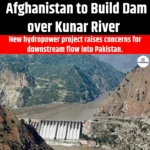|
GS Paper 2: Government Policies and Interventions GS Paper 3: Environment, Conservation, Pollution, Biodiversity & Environment |
Why in the News?
Recently, the 57th Executive Committee meeting of the National Mission for Clean Ganga (NMCG) approved several important projects aimed at improving the conservation and cleanliness of the Ganga River.
These initiatives will also focus on Information, Education, and Communication (IEC) activities for the upcoming Mahakumbh 2025.
Key Projects Approved
Sewage Treatment Plants (STPs): The Committee approved the establishment of STPs in Bihar’s Katihar and Supaul, and in Uttar Pradesh’s Aligarh. These plants aim to remove contaminants from sewage to ensure cleaner water is released into natural water bodies.
Monitoring STPs: The introduction of an Online Continuous Effluent Monitoring System (OCEMS) was approved to enhance the real-time monitoring of existing STPs in the Ganga River Basin.
IEC Activities for Mahakumbh 2025: A project aimed at raising awareness during Mahakumbh 2025 was approved, including beautification efforts such as ‘Paint My City’ and mural art.
PIAS Project: The restructuring of manpower under the Pollution Inventory, Assessment, and Surveillance (PIAS) project was sanctioned to improve its efficiency. This project, overseen by the Central Pollution Control Board (CPCB), monitors industrial pollution.
SLCR Project: The Committee approved crucial components of the ‘Smart Laboratory for Clean River’ (SLCR) project, designed to accelerate the restoration of small rivers across the nation.
Turtle and Gharial Conservation: A conservation breeding program for freshwater turtles and gharials at the Kukrail Gharial Rehabilitation Center in Lucknow, Uttar Pradesh, was approved.
National Mission for Clean Ganga (NMCG): Overview
- Established: NMCG was registered as a society on August 12, 2011, under the Societies Registration Act, 1860, to play a key role in the Ganga River’s rejuvenation and protection.
- Legal Framework: Initially, NMCG functioned under the National Ganga River Basin Authority (NGRBA), which was formed under the Environment (Protection) Act of 1986. After NGRBA’s dissolution in 2016, NMCG now acts as the implementing arm of the National Ganga Council.
- Management Structure: NMCG has a two-tier management structure, with both levels led by the Director General.
- Governing Council: Oversees the general direction and policies of NMCG.
- Executive Committee: Authorized to approve projects with financial outlays up to ₹1,000 crores.
- Five-Tier Ganga Rejuvenation Structure: Envisioned by the Environment Protection Act, 1986, this structure ensures effective management at national, state, and district levels, with bodies like the National Ganga Council, Empowered Task Force, and State/District Ganga Committees.
Namami Gange Programme
About: Launched in 2014 with a budget of ₹20,000 crore, this flagship program aims to reduce pollution, and conserve, and rejuvenate the Ganga River.
Key Pillars:
- Sewage treatment infrastructure to manage wastewater.
- River-surface cleaning to remove solid waste.
- Afforestation to restore green cover.
- Monitoring industrial effluents.
- River-front development to engage communities and boost tourism.
- Biodiversity conservation.
- Public awareness to promote river conservation.
- Ganga Gram initiative to develop model villages along the river.
Integrated Mission Approach: The program links economic development with ecological sustainability, prioritizing clean energy, biodiversity conservation, and wetland development.
Thames River Restoration Case Study
- Overview: In the 1950s, the Thames was considered “biologically dead” due to pollution from urban and industrial waste. A significant turning point came during the Great Stink of 1858, which led to public health concerns and the construction of a sewage system.
- Recovery Efforts: From the 1970s onwards, treated sewage, improved water regulations, and the installation of oxygenators (bubblers) helped restore the river’s dissolved oxygen levels, improving aquatic life.
National Ganga Council (NGC)
- Formation: NGC was established in 2016 under the Environment (Protection) Act, 1986, replacing the National Ganga River Basin Authority.
- Objective: To ensure the rejuvenation and management of the Ganga and its tributaries through coordinated actions.
- Governance: Chaired by the Prime Minister, the Council involves the Chief Ministers of states through which the Ganga flows, such as Uttarakhand, Uttar Pradesh, Bihar, Jharkhand, and West Bengal.
Challenges in the Namami Gange Programme
Data and Monitoring Gaps: Of the 457 projects undertaken by December 2023, only 280 were completed. There is limited data on whether the constructed sewage treatment plants are functional.
Neglect of Tributaries: Smaller rivers like the Gomti are often overlooked, hindering broader clean-up efforts.
Industrial Pollution: Untreated industrial waste from tanneries in Kanpur remains a significant issue, with high levels of harmful substances like chromium being discharged.
Financial Management: Reports from the CAG highlighted the underutilization of funds (8-63%) between 2014-2017 and raised concerns about excessive spending on media campaigns.
Environmental Threats: Illegal sand mining and riverfront projects, which require dredging, disrupt the natural flow of the Ganga.
Way Forward
- Improving Financial Management: Ensure efficient and transparent fund allocation, with proper auditing and reporting.
- Strengthening Regulations: Encourage eco-friendly technologies and sustainable waste management through industrial incentives.
- Focus on Tributaries: Implement targeted measures to improve tributary health, including restoring biodiversity.
- Enhanced Data Monitoring: Develop a centralized database to track all projects under the Namami Gange programme for better oversight and progress measurement.
Explore our Books: https://apnipathshala.com/product-category/books/
Explore Our test Series: https://tests.apnipathshala.com/









